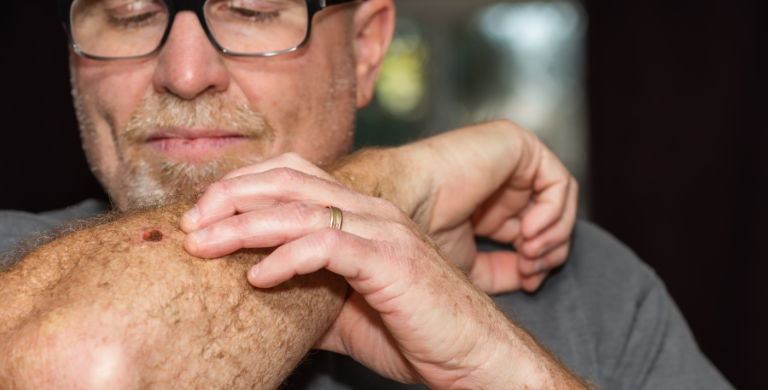Skin cancer is the most common type of skin cancer. There are three main types of skin cancer, basal cell carcinoma (BCC), squamous cell carcinoma (SCC), and melanoma. Not all skin cancers have the same symptoms. Skin cancer occurs when skin cells grow irregularly, and healthcare professionals use these cells to identify the type of cancer through a biopsy. Being vigilant for changes in your skin may help you get a diagnosis earlier.
Basal cell carcinoma (BCC)
Basal cell carcinoma is primarily caused by long-term sun or ultraviolet (UV) light exposure. It usually appears on the skin’s surface and looks like sores, growths, bumps, scars, or red patches. It begins in the skin cells that replace old cells in the lower epidermis, resulting in tumors. It is usually non-life-threatening but can spread to other body parts in rare cases. Treatment for basal cell carcinoma involves removing the growth. Your healthcare professional will select the treatment method depending on the lesion’s type, size, and location.
Squamous cell carcinoma (SCC)
Squamous cell carcinoma (SCC) is the second most common form of skin cancer that develops due to changes in the DNA of squamous cells, which causes them to reproduce. Because it is caused by ultraviolet (UV) light exposure, it is usually found on the head, neck, chest, upper back, ears, lips, arms, legs, and hands. SCC can become life-threatening when not treated in its early on set, as it can spread to the tissues, bones, and nearby lymph nodes. This cancer can resemble a wart, a red, scaly patch of skin, a recurring open sore, or a growth with raised edges that might bleed or itch. A variety of in-practice treatments are available when detected early; talk to your doctor about the different options best suited for your condition.
Melanoma
Melanoma is life-threatening and should be treated as early as possible. This type of cancer develops from the melanocyte cells that provide colour to your skin. Noncancerous moles are formed by melanocytes but can become cancerous. Melanomas can develop anywhere in your body but is most common on the chest and back in men and on the legs in women. A mole can be melanoma when it has an irregular shape and border, is multicolored or has uneven coloring, has larger than a quarter of an inch, and changes in size, shape, color, itches, or bleeds. Treatment depends on the stage of melanoma. During its early stages, Melanoma can be treated in practice.
When to see a doctor
If you experience any of the symptoms above, it is best to visit your healthcare professional as soon as possible. Your doctor will examine the shape, size, colour, and texture of your skin concern. If your doctor suspects it might be cancerous, they may perform a biopsy, removing the suspicious and sending them to a lab for testing. Your doctor can refer you to a specialist if you receive a skin cancer diagnosis for additional tests and a treatment plan.
Intercare Day Hospital
A convenient, clean, and safe place to remove skin cancer. Intercare Day Hospitals (Outpatient Surgery Centres), carry out procedures that do not require an overnight hospital stay. Intercare day hospitals’ surgical services prioritise patient safety and comfort, utilising procedure-related techniques and technology. This approach accelerates the healing process by getting patients home and back into comfortable surroundings as quickly as possible.












